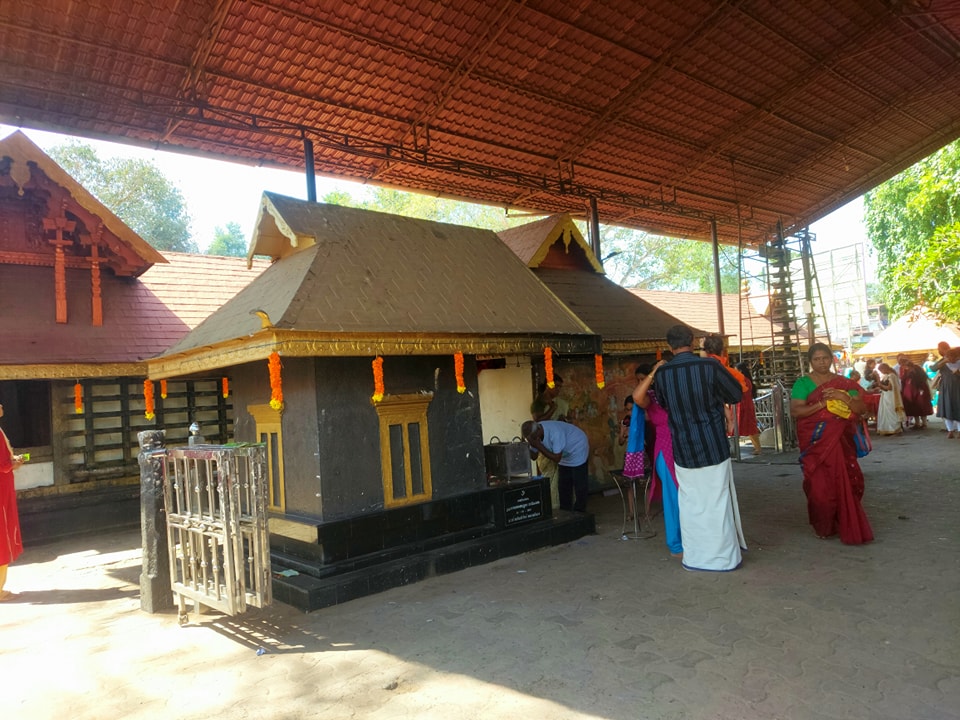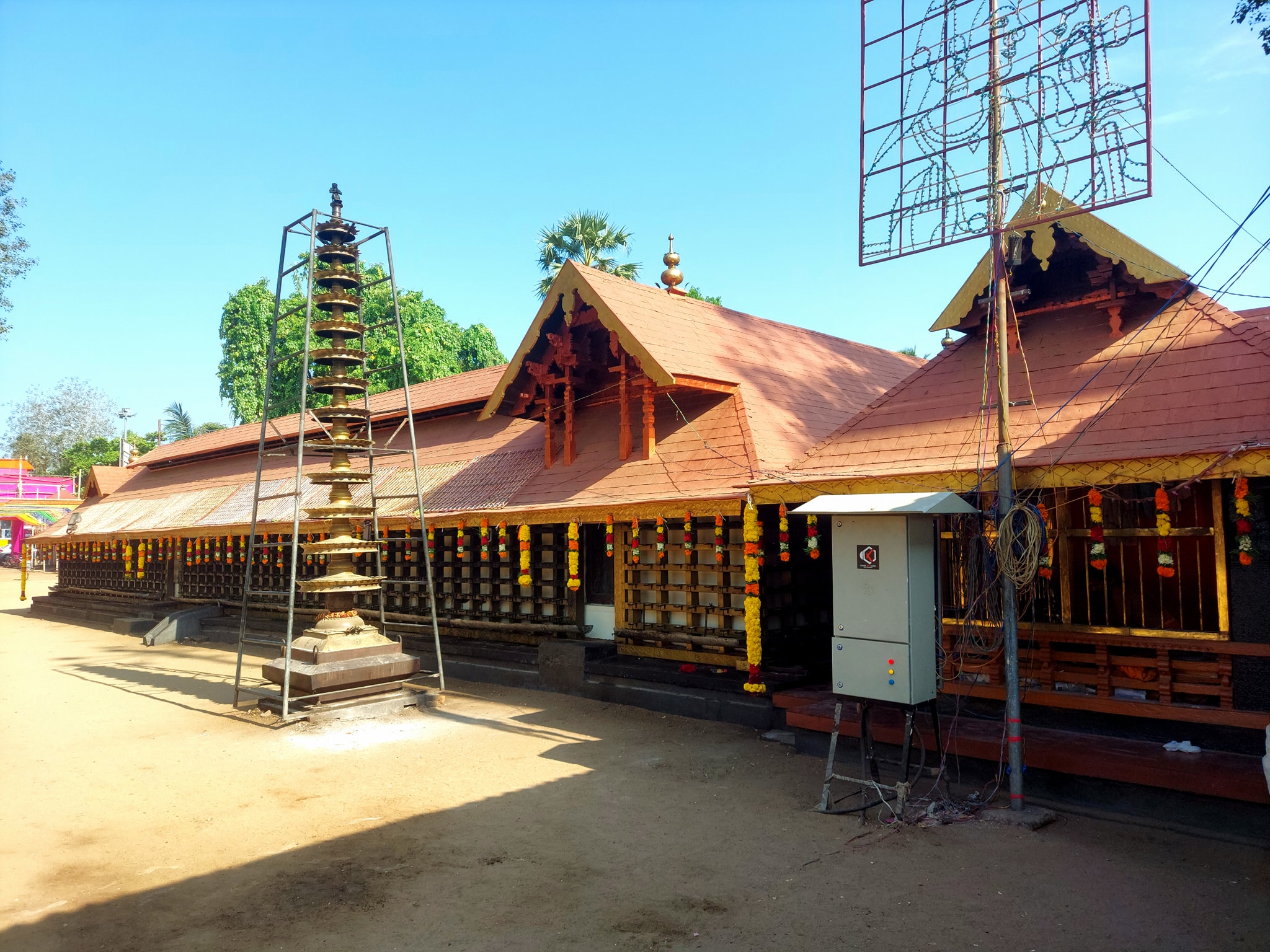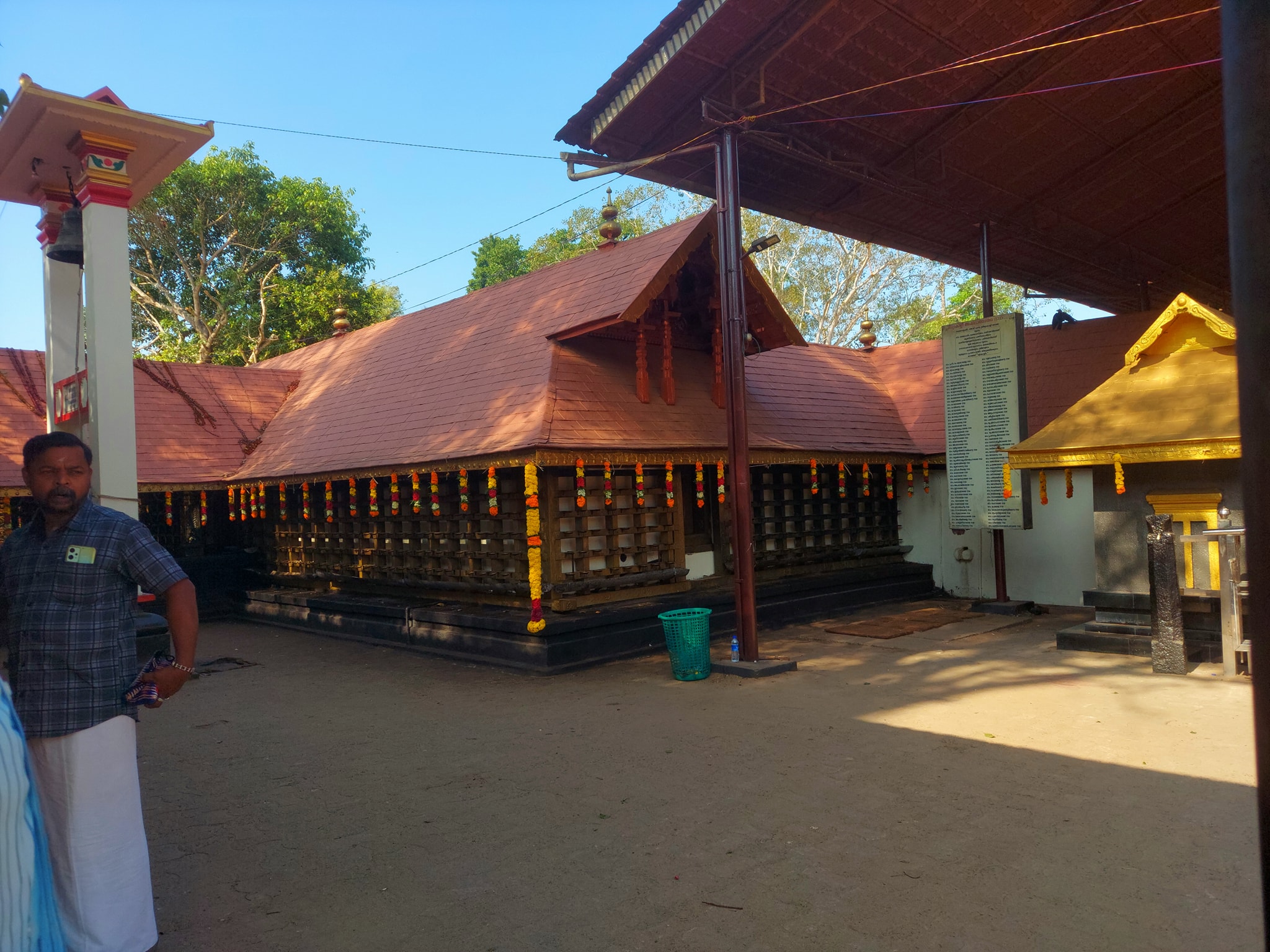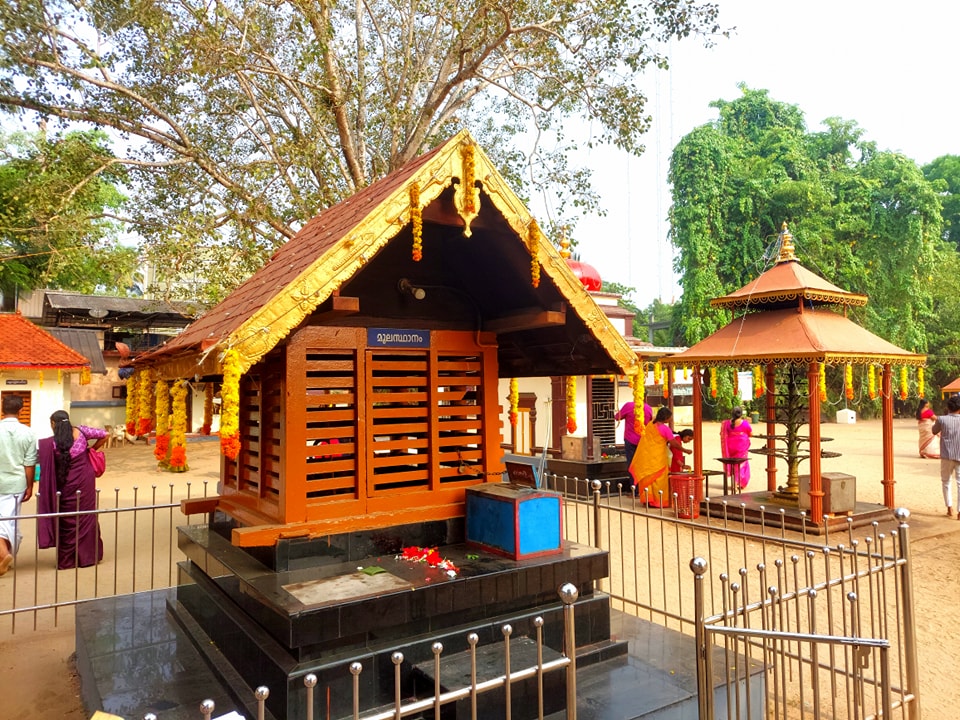Chettikulangara Sree Bhagavathi Temple is among the most prominent Hindu temples located in Kerala, with the principal deity being Sree Bhadrakali.

Bhadrakali is an embodiment of the supreme mother Shakthi Devi, emerging from the third eye of Lord Shiva with the purpose of vanquishing the demon king Daruka. The term 'Bhadra' signifies goodness, while 'Kali' refers to the goddess of time. Consequently, Bhadrakali is revered for her blessings of prosperity and salvation. The Devi is acknowledged as the creator, protector, and destroyer, as well as a representation of nature, power, and Kundalini Shakthi. Kuthiramoottil kanji and Therummoottil kanji represent significant offerings at the Chettikulangara Devi temple.
Numerous widely held beliefs exist regarding the origins of the Chettikulangara temple, with the most prominent narrative being as follows. Centuries ago, a group of local chieftains attended the annual celebrations at the Koypallikarazhma Bhagavathi temple, located a few kilometers from Chettikulangara. During their visit, they faced humiliation and mockery from the temple authorities and the village chieftains. Disturbed by this treatment and motivated by a desire for retribution, they resolved to establish a Bhagavathi temple in Chettikulangara. The community rallied together for this purpose, led by the Karanavars (Family Heads) of the prominent families in the area. They sought the blessings of Kodungallur Bhagavathi for their endeavor.
Their journey included a pilgrimage to various temples along the way, culminating in their arrival at Kodungallur, where they engaged in Bhajanam for twelve days to honor the Goddess. It is said that the Devi appeared to them in their dreams, assuring them of her imminent arrival in Chettikulangara. The following day, they joyfully returned home with a sacred sword bestowed upon them by the Velichappadu of the Kodungallur temple, and commenced the construction of the temple. A few days later, as the kadathukaran (local boatman) of the nearby Karippuzha rivulet was concluding his work on a late evening, he heard an elderly woman asking for his assistance to cross to the other side. Recognizing it as his duty to aid this solitary lady, he agreed to take her to Chettikulangara, her stated destination. During their journey, they paused for rest beneath a tree by the roadside (the site now occupied by the Puthusseriambalam temple), where the kadathukaran procured food from a nearby washerman's residence.
Before long, he succumbed to sleep, and upon awakening at dawn, he discovered that the lady had disappeared. It is said that this boatman was a Christian, and by assisting Devi in crossing the Karippuzha thodu, his family was later entrusted with the responsibility of Vedi (ritual fireworks at the temple). He recounted this enigmatic event to the residents of Chettikulangara, who believed that the Devi had successfully reached her destination. The following day, annual maintenance activities were underway on the thatched roof of the illam, the traditional residence of a Brahmin community in central Kerala, located next to the current temple.
While the Antharjanam of the house was serving Kanji (rice porridge), muthirapuzhukku (a local delicacy made from baked Horse Gram and kneaded coconut), and Asthram (a side dish consisting of a paste made from various locally sourced vegetables) to the workers, an unusual elderly woman joined them for lunch. Shortly after the meal, the old woman moved to the western side of the house and disappeared in a radiant glow. The Antharjanam witnessed this event and subsequently fainted. Later, she recounted her experience to the villagers.
On the same day, Devi made her presence known to the village chieftains. They consulted renowned astrologers, who confirmed that the Bhagavathi had indeed arrived in Chettikulangara. The principal Upadevathas located within the temple grounds include Yakshini, Ganapathi, Nagarajav, Balakan, Muhurthi, Naga Yakshi, Thevara Moorthy, Kannamballi Bhagavathi, Rekshas (a formidable supernatural entity that preys on humans), and Vallyachan (a term used in Central Travancore to refer to family chieftains, who are venerated by their descendants posthumously).
Additionally, there exists a small temple dedicated to Moolasthanam, the primary abode. The site also features a Kavu, a small forest area that serves as a sanctuary for serpent deities, a common characteristic in Central Travancore. Within the premises, the Karimbana and Chembakam trees are regarded as sacred, believed to be inhabited by Gandharvas and Yakshis, supernatural beings that accompany Bhagavathy, their master, during her journeys, referred to locally as Varuthu Pokku. For centuries, it has been customary to refrain from bringing elephants to the western side of the Nalambalam, as there is a prevailing belief that the fairy beings residing in the Chembakam pose a threat to their safety. In the many temples of Onattukara, the "Parayeduppu" period marks the festive season.
This celebration commences with the procession of the deity, known as "Devi," from the Chettikulangara temple, which takes place on the Makayriam star during the Malayalam month of Makaram. The festivities extend until the conclusion of Meenam. A central feature of Parayeduppu is the Jeevatha, designed to resemble the temple structure itself. This carriage, akin to a palanquin, is supported by two teakwood poles approximately two meters in length. The front of the Jeevatha is reminiscent of a "Thidambu," accompanied by a small chest, or pettakam, constructed according to Thachusaasthra principles. Adorning the front is a woollen cloth embellished with vibrant, shimmering images and gold ornaments. Behind this, the deity's sacred attire is meticulously starched, pleated, and adorned with small mirrors. Over 100 families participate in the three-month-long visit of Parayeduppu Bhagavathy to the homes within her designated Karas.
The rhythms accompanying the Jeevatha Ezunnallathu (procession) are particularly remarkable, beginning with slow beats that gradually build to a crescendo before concluding with rapid rhythms. The musical ensemble features the Veekkan chenda and Uruttu chenda (both types of drums) along with Elathaalam (cymbals). While Jeevatha Ezunnallathu and Parayeduppu are age-old traditions, the "Chuvadu Vechu Kali," characterized by its distinctive dance steps, is a more recent addition. The principal celebration at Chettikulangara is Kumbha Bharani, which occurs in February or March. The specific date is determined by the Malayalam Calendar KollaVarsham. The festival is named Kumbha Bharani as it is celebrated in the month of Kumbha and on the day associated with the Bharani star. The festival's main attractions are Kuthiyottam and Kettukazhcha.
Preparations for Kumbha Bharani commence seven days prior to the event, typically coinciding with Shivarathi. Individuals who have made vows for Kuthiyottam begin training their children for the offering on Shivarathi. During this period, these families host communal gatherings and provide meals for attendees. The children are instructed in a unique dance known as Kuthiyota chuvadukal. Concurrently, the residents from the 13 karas of Chettikulangara organize the construction of their Kettukazhcha for the temple.
On the day of the festival, the Kuthiyottam processions begin early in the morning and continue until the afternoon. Those who have pledged Kuthiyottam to Devi bring their children to the temple in a procession, presenting them as offerings.
The boys perform the Kuthiyottam dance in front of Devi. In the evening, the focus shifts to the Kettukazhcha, with participants from each locality transporting their Kettukazhcha from their construction sites to the temple to present them to Devi. After receiving darshan, the groups proceed to their designated positions in the paddy fields located east of the temple. During the night, the image of Devi is paraded to the Kettukazhcha situated in the paddy fields. The following day, these structures are returned. Additionally, a large market known as Bharani Chanda is held in Chettikulangara as part of the festivities.
The annual temple festival takes place on the tenth day after Kumbha Bharani and lasts for a duration of 13 days. Each day of the festival is coordinated by the residents of the 13 Karas. Special rituals are performed within the temple grounds. Every afternoon, cultural processions commence from each Kara, making their way to the temple, accompanied by drums, decorated umbrellas, kuthiyottam songs, reenactments from the Mahabharata and Ramayana, classical art forms, folk art, various musical styles, ornate structures, and caparisoned elephants. During the temple rituals, Thottampattu, a devotional song, is performed by a specific segment of the community from distant Trivandrum. This song is exclusively sung in the temple during the Etheralpu festival.
In the evenings, performances of classical arts and other temple-related art forms are held within the temple premises. Kuthiras reach a height ranging from approximately 70 to 105 feet and consist of four distinct components: Adikkoottu, Kathirakal, Edakkodaram, and Melkkoodaram, arranged in a vertical sequence. The Adikkottu, also referred to as Vandikkoottu, serves as the foundational structure, comprising four large wooden wheels interconnected with four beams positioned above them. Kuthiras are equipped with Thandu, which are two substantial wooden poles that assist in steering during movement. The Thandu and the foundational structure are linked and feature reinforced wooden bearings akin to contemporary shock absorbers.
Edakkoodaram, which is nearly half the height of Kathirakal, is situated above it and includes four to five Charippu in its lower section. This component is adorned with shimmering fabrics and Vella, embellished with vibrant Thookku decorations. The Melkkoodaram, the uppermost structure, is characterized by its pyramid shape and features a prominent elongated sculpted wooden pole, known as ‘Nambu,’ which is painted white. All individual components are elevated and stacked using wooden pulleys, large coir ropes called Vadams that exceed 100 feet in length, and substantial iron structures. Kuthiyottam is conducted as a significant offering to the deity. This ritual dance has been practiced and refined over several centuries.
Traditionally, it was performed exclusively within the 13 Karas of the Chettikulangara Temple; however, following a recent Deva Prashnam, it has been permitted to take place in residences beyond these 13 Karas. Homes are adorned, and a portrait of the deity is set up in temporary structures. The Kuthiyottam festivities commence one week prior to Bharani day. This folk dance is performed by young men, accompanied by folk music and various musical instruments. Boys aged between 8 and 14 years are instructed in this ritual dance within a vibrant social gathering, all taking place before the deity's portrait. Additionally, feasts are organized for all attendees.
On the morning of Bharani, following the feast and other rituals, the boys, whose bodies are wrapped in silver wires—one end secured around their necks with an arecanut balanced on a knife held aloft—are paraded to the temple.
This procession is accompanied by the rhythmic beating of drums, music, ornamental umbrellas, and other traditional folk art forms, along with elaborately adorned elephants. Throughout the journey to the temple, tender coconut water is continuously poured over their bodies. Upon reaching the temple, the boys circumambulate and then position themselves facing the Sreekovil (Sanctum Sanctorum) to begin their dance. The ceremony concludes with the removal of the coil, which pierces the skin, resulting in a few drops of blood.
ചെട്ടികുളങ്ങര ശ്രീ ഭഗവതി ക്ഷേത്രം
കേരളത്തിലെ ആലപ്പുഴ ജില്ലയിൽ മാവേലിക്കര താലൂക്കിൽ കായംകുളം തിരുവല്ല സംസ്ഥാന പാതയിൽ കായംകുളത്തിനും മാവേലിക്കരയ്ക്കും ഇടയിൽ സ്ഥിതിചെയ്യുന്ന പ്രശസ്തമായ ക്ഷേത്രമാണ് ചെട്ടികുളങ്ങര ശ്രീ ഭഗവതീ ക്ഷേത്രം. മാവേലിക്കര ടൗണിൽ നിന്ന് 3 കിലോമീറ്റർ അകലവും കായംകുളത്തിനു വടക്കായി 6 കിലോമീറ്റർ മാറിയുമാണ് ഈ ക്ഷേത്രം സ്ഥിതിചെയ്യുന്നത്. തിരുവിതാംകൂർ ദേവസ്വം കണക്കുകൾ പ്രകാരം, ശബരിമലയെക്കാൾ കൂടുതൽ വരുമാനം ഈ ക്ഷേത്രത്തിൽ നിന്നാണ് ലഭിക്കുന്നത്. ഹൈന്ദവ, ശാക്തേയ വിശ്വാസപ്രകാരം, ജഗദീശ്വരിയും ആദിപരാശക്തിയുമായ ശ്രീ ഭദ്രകാളി ആണ് ഈ ക്ഷേത്രത്തിന്റെ മുഖ്യ പ്രതിഷ്ഠ. ചെട്ടികുളങ്ങര അമ്മ എന്ന പേരിൽ ഭഗവതി അറിയപ്പെടുന്നു.
ഭദ്രകാളി, പരാശക്തിയുടെ പ്രധാന ഭാവങ്ങളിൽ ഒന്നായാണ് പ്രതിഷ്ഠ ചെയ്തിരിക്കുന്നത്. കിഴക്കൻ ദർശനത്തിൽ, ചെട്ടികുളങ്ങരയിലെ ഭഗവതി പ്രതിഷ്ഠ മറ്റുള്ള ക്ഷേത്രങ്ങളിൽ നിന്നു വ്യത്യസ്തമായ ബഹുവേര രീതിയിൽ നടന്നു. മുഖ്യ പ്രതിഷ്ഠ ദാരുബിംബമായ ഭദ്രകാളിയുടെ വരിക്കപ്ലാവിൽ കൊത്തിയെടുത്ത രൂപമാണ്. കൂടാതെ, കണ്ണാടിയിൽ ഭദ്രകാളിയുടെ ചെറിയ കർമ്മ ബിംബവും, ഗുരുസി ബിംബവും ചേർന്നാണ് ഇവിടെ പ്രതിഷ്ഠ. ദേവി ഭാഗവത പ്രകാരം, ആദിപരാശക്തിയുടെ മൂന്നു പ്രധാന ഭാവങ്ങളിൽ ഭദ്രകാളി ഒന്നാണ്. ദാരികനെ വധിക്കാൻ ശിവന്റെ നേത്രാഗ്നിയിൽ നിന്നാണ് ശ്രീ ഭദ്രകാളി അവതരിച്ചത് എന്ന് ശൈവ ശാക്തേയ പുരാണങ്ങൾ പറയുന്നു.
പ്രാചീന കാലത്തെ മാതൃദൈവാരാധന, ഊർവരത, മണ്ണിന്റെ ഫലഭൂയിഷ്ടി, കാർഷിക സമൃദ്ധി, യുദ്ധ വിജയം എന്നിവയുമായി മാതൃ ദൈവാരാധനയുടെ ബന്ധം നിലനിൽക്കുന്നു. ഈ ക്ഷേത്രം 1200 വർഷം പഴക്കമുള്ളതാണ്, ഇവിടെ ഭഗവതിയുടെ പ്രതിഷ്ഠയാണ്. ഭഗവതിയെ പ്രഭാതത്തിൽ മഹാസരസ്വതിയായി, ഉച്ചയ്ക്ക് മഹാലക്ഷ്മിയായി, വൈകുന്നേരത്തിൽ ശ്രീ ദുർഗ്ഗയായി പൂജിയ്ക്കുന്നു എന്നതാണ് വിശ്വാസം. കേരളത്തിൽ ശബരിമലയെക്കാൾ കൂടുതൽ വരുമാനം ലഭിക്കുന്ന ക്ഷേത്രമാണിത്. ആദിശങ്കരന്റെ ശിഷ്യനായ പത്മപാദ ആചാര്യനാണ് ഈ ക്ഷേത്രം സ്ഥാപിച്ചതെന്ന് കരുതപ്പെടുന്നു. മരം കൊണ്ടുള്ള വിഗ്രഹമാണ് ഇവിടെ ഉള്ളത്, അതിനാൽ ചാന്താട്ടം പ്രധാന ചടങ്ങായി കണക്കാക്കപ്പെടുന്നു. തേക്കിൻറെ തടിയിൽ നിന്നെടുത്ത ദ്രാവകം ഒമ്പത് കുടങ്ങളിലാക്കി പൂജിച്ച്, ഉച്ചപൂജയ്ക്കായി ദാരുവിഗ്രഹത്തിൽ അഭിഷേകം ചെയ്യുന്നതാണ് ചാന്താട്ടത്തിന്റെ പ്രക്രിയ.
ശിലാ വിഗ്രഹങ്ങൾ നിലനിൽക്കാൻ എണ്ണകൊണ്ട് അഭിഷേകവും, ദാരു വിഗ്രഹങ്ങൾ കേടാകാതിരിക്കാൻ ചാന്താട്ടവും നടത്തപ്പെടുന്നു. ഈ സ്ഥലം ഒരു ബുദ്ധ ക്ഷേത്രമായിരുന്നു എന്ന അഭിപ്രായം ഉണ്ട്. ക്ഷേത്രത്തിന്റെ പ്രശസ്തി ബൗദ്ധ ഉത്സവത്തിന്റെ തുടക്കമായിട്ടുണ്ടെന്ന് കരുതപ്പെടുന്നു.
ഈ ക്ഷേത്രത്തിൽ 13 കരങ്ങൾ ഉൾപ്പെടുന്നു. ഈരേഴ തെക്ക്, ഈരേഴ വടക്ക്, കൈത തെക്ക്, കൈത വടക്ക് എന്നിവയാണ് ക്ഷേത്രത്തിന്റെ നാലു പ്രധാന ഭാഗങ്ങൾ. മറ്റ് കരങ്ങൾ കണ്ണമംഗലം തെക്ക്, കണ്ണമംഗലം വടക്ക്, പേള, കടവൂർ, ആഞ്ഞിലിപ്ര, മറ്റം വടക്ക്, മറ്റം തെക്ക്, മേനാമ്പള്ളി, നടയ്ക്കാവ് എന്നിവയാണ്.
കുംഭഭരണി കൂടാതെ മീനത്തിലെ അശ്വതി നാളിലും ഇവിടെ കെട്ടുകാഴ്ച നടക്കും. ഇത് കുട്ടികളുടെ കെട്ടുകാഴ്ച എന്ന പേരിൽ അറിയപ്പെടുന്നു. കൊടുങ്ങല്ലൂരിൽ നിന്നുള്ള പുതുപ്പുരയ്ക്കൽ ഉണ്ണിത്താനും കൈത തെക്ക് മങ്ങാട്ടച്ചനും ചെമ്പോലിൽ താങ്കളും കൊടുങ്ങല്ലൂരിൽ ഭജനയിരുന്ന് ദേവിയെ ചെട്ടികുളങ്ങരയ്ക്ക് ആവാഹിച്ചു കൊണ്ടുവന്ന കഥയാണ് ഇത്. അശ്വതിനാളിൽ കെട്ടുകാഴ്ച നടന്നാൽ മീനഭരണി ദിനത്തിൽ ഇവിടെ നട ആരംഭിക്കില്ല. ഭഗവതി കൊടുങ്ങല്ലൂരിലേക്ക് പോകുന്നു എന്നതാണ് വിശ്വാസം. ക്ഷേത്രത്തിനു മുന്നിൽ 13 തട്ടുള്ള ആൽ വിളക്കുകൾ ഉണ്ട്. 1001 തിരികൾ കത്തിക്കാനുള്ള ഈ വിളക്കുകളുടെ തട്ടുകൾ പതിമൂന്ന് കരകളെ പ്രതിനിധീകരിക്കുന്നു.
നാലമ്പലത്തിന്റെ വാതിലുകളിലും ക്ഷേത്രത്തിന്റെ ചുവരുകളിലും മനോഹരമായ ശിൽപങ്ങൾ കാണാം. ചാന്താട്ടവും കുത്തിയോട്ടവുമാണ് പ്രധാന വഴിപാടുകൾ. അർച്ചന, തുലാഭാരം തുടങ്ങിയ മറ്റ് വഴിപാടുകളും ഉണ്ട്.
മകരഭരണി ദിനം വരുമ്പോൾ ചെട്ടികുളങ്ങര ക്ഷേത്രത്തിൽ സപ്താഹ യജ്ഞം നടത്താറുണ്ട്. ഇതോടൊപ്പം സമൂഹസദ്യയും നടത്തപ്പെടുന്നു. വൃശ്ചികത്തിലെ ഭരണി മുതൽ ചെട്ടികുളങ്ങരയിൽ ഉത്സവകാലം ആരംഭിക്കുന്നു. വൃശ്ചിക ഭരണിക്ക് വിഗ്രഹം കൈവെള്ളയിൽ ഏന്തിയാണ് എഴുന്നള്ളുന്നത്. എന്നാൽ ധനുമാസം മുതൽ മീനത്തിലെ അശ്വതിവരെ തോളിൽ ഏറ്റി നടക്കാവുന്ന ജീവിതത്തിൽ വിഗ്രഹം എഴുന്നള്ളിക്കുന്നു.
മകരത്തിലെ ഭരണി കഴിഞ്ഞ് വരുന്ന മകയിരം നാളിൽ കൈനീട്ടപ്പറ - ഇത് പുരാതന തറവാടായ ചെമ്പോലിൽ നിന്നാണ്. പൂയം മുതൽ പറയ്ക്കെഴുന്നള്ളിപ്പാണ്. ഈരേഴ തെക്ക്, ഈരേഴ വടക്ക്, കൈത തെക്ക്, കൈത വടക്ക്, കണ്ണമംഗലം തെക്ക്, കണ്ണമംഗലം വടക്ക്, പേള, കടവൂർ, ആഞ്ഞിലിപ്ര, മറ്റം തെക്ക്, മറ്റം വടക്ക്, മേനാംപള്ളി, നടൈക്കാവ് എന്നീ പതിമൂന്ന് കരകളിൽ നിന്നാണ് പറയെടുപ്പ്. കെട്ടുകാഴ്ച, കാർത്തിക പൊങ്കാല, പറയെടുപ്പ് മഹോത്സവം, കുതിരമൂട്ടിൽ കഞ്ഞി എന്നിവയെക്കുറിച്ച് പറയുമ്പോൾ, കുതിരമൂട്ടിൽ കഞ്ഞി ഭക്തജനങ്ങൾ നടത്തുന്ന ഒരു നേർച്ചയാണ്.
പരമ്പരാഗത രീതിയിൽ തന്നെ ഈ ചടങ്ങുകൾ ഇന്നും നടത്തപ്പെടുന്നു. ഭദ്രാ ഭഗവതി ഈ പ്രദേശത്ത് എത്തിയപ്പോൾ ആദ്യമായി കഴിച്ച ആഹാരം എന്ന ആശയവും ഇതിന് പിന്നിൽ ഉണ്ട്. ഇല, തട, പ്ലാവില എന്നിവയാണ് ഇപ്പോഴും ഉപയോഗിക്കുന്നത്. മുതിരപ്പുഴുക്കും, അസ്ത്രവും, കടുമാങ്ങയും ഈ വിഭവങ്ങളിൽ ഉൾപ്പെടുന്നു. വഴിപാട് നടത്തുന്ന വ്യക്തിയുടെ കഴിവനുസരിച്ച് കഞ്ഞിസദ്യയിലെ വിഭവങ്ങളുടെ എണ്ണം കൂടുകയും ചെയ്യുന്നു. എതിരേൽപ്പ് ഉത്സവം, മീനം-അശ്വതി, ഭരണി, കാർത്തിക, കൊഞ്ചുംമാങ്ങ കറി എന്നിവ ക്ഷേത്രവുമായി ബന്ധപ്പെട്ട പ്രധാന ആചാരങ്ങളാണ്.
Address:
Chettikulangara,
Mavelikara, Kerala 690106



